You are reading the older HTML site
Positive Feedback ISSUE
july/august 2008
Audio Ramblings - A Journey
Begins: Computer Based Audio
by Dave Clark

Ah yes …the shift to a computer based audio system. With the addition of the Cary 306 in the house-hold (either the older or the newer one—really doesn't matter as they both allow for several options for inputting a digital signal: AES/EBU, Toslink, USB, or any combination of the three) I sat down and thought what the heck… how should I start this?
Hey, I have a brand new Dell Inspiron laptop sitting here that I had just bought for my classroom …not using it right now, so let's toss it into the mix. The Dell 1525 looks good paper (Intel® Core™ 2 Duo T5750 - 2.00GHz/667Mhz FSB/2MB cache, Vista, 250GB HD, and 3GB of memory) but it only offers USB out, so I need a USB cable… and since the Cary does not have a USB in, I will need some type of converter that converts USB to S/PDIF …which then means that I will also need a digital coax cable to get the digital signal into the Cary! Yikes this is getting confusing….
Alright so here is what I did… and subsequently learned more than I had bargained for in getting my music from here to there.
In looking at what I wanted—ease of use and convenience—I decided to go with the iTunes. Programs such as JRiver and Foobar (along with other more pro-ended choices) just did not offer the simplicity that I was looking for, though they may be superior in many ways. I wanted something quick and simple and iTunes was it. Easy to configure (rip as lossless with error correction and equalizer off) and I was able to rip CDs with ease. Plus I could add art work and tags to the CDs making things fun, easy to organize, and nice to look at. The others offered too steep of a learning curve and did not offer lossless playback (they go for FLAC). Why lossless and not AIFF or something else for that matter? Again, ease of use and convenience… besides I was told from someone in the know that any audible differences between the bunch are minor and well …rather moot when one considers the ultimate goal: ease of use and a quick musical fix. My intent was to not to go after the end-all system, but one that I could store my music on and play back for a more casual—though at an acceptable audiophile level—listening experience.
As to a USB cable… lots to choose from. You can get the usual stock ones for a few dollars and then you can go over the top for those from the audiophile community— these will set you back a bit. Kimber tossed in their version (heavy silver-plated (6.1%) signal conductors, maximum gauge—under USB™ spec.—signal and power conductors, nitrogen-infused polyethylene signal conductor dielectric and a Ferrite noise reduction beads on each end of the cable - $50) as did Lee Wieland of Cryo-Parts (cryo-treated USB cable with two layers of shielding, one of these a being a very trick carbon fiber based material and some ERS fabric at key places - $70). Both work quite well over a stock or generic USB cable, and will not set you back too far.
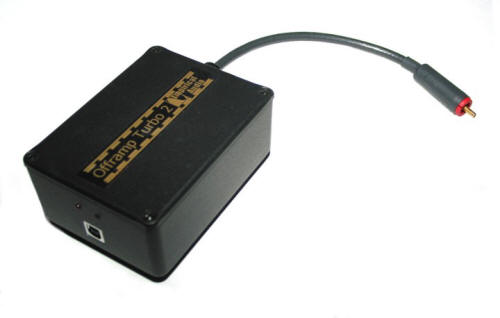
In looking for a USB to S/PDIF interface the end user is offered many options. The converters that I have here are the Pop Pulse PC Link II (based on the CM-108 USB audio I/O controller and allows for S/PDIF and AES/EBU digital outs at 16/44.1 or 24/96kHz - $129.95 from Cryo-Parts.com), the Hagerman HagUsb (based on PCM2704 USB audio I/O controller and outputs S/PDIF at 16 bits/32kHz, 44.1kHz, or 48kHz - $105 from Hagerman himself), and the Empirical Audio Off-Ramp Turbo 2 (based on the TAS1020B USB audio I/O controller with a S/PDIF output at 16/44.1 or 24/96 kHz - $990 from Empirical Audio).
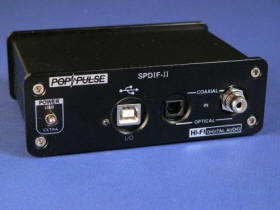
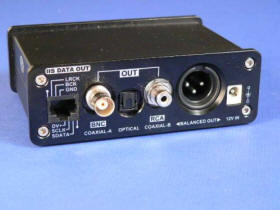
All worked fine
though obviously they sound different. The HagUSB is perhaps the simplest of the
lot, but only will deal with 16/44.1. The converter offers a warm, rich sound
that lacks in ultimate resolution and transparency. It is a simpler device than the
other two and as such, well… the sound is simpler. But it is still quite
musical, it just is not going to present the same musical perspective as say the
way more pricey and elaborate Off-Ramp. The Off-Ramp provides substantially more
resolution, and therefore
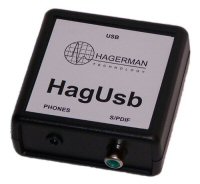 more detail or information that results in a
considerably more involving and dimensional musical perspective—but it is
almost 10 times the price. The Pop Pulse falls somewhere in between, though in
absolute terms it lies closer to the sound of the Hagerman than the Empirical. I
will be going into more detail on these in later issue, so stay tuned, but the
word is that the better the USB implementation in the converter (that is the
specific USB chip set used and how it syncs or does not sync to the computer's
clock) the better the sound. Empirical and Benchmark (along with Wavelength) all
use the better chips sets, which is why they sound better overall. Of course
even then how those chips are implemented is a whole 'nother
issue.
more detail or information that results in a
considerably more involving and dimensional musical perspective—but it is
almost 10 times the price. The Pop Pulse falls somewhere in between, though in
absolute terms it lies closer to the sound of the Hagerman than the Empirical. I
will be going into more detail on these in later issue, so stay tuned, but the
word is that the better the USB implementation in the converter (that is the
specific USB chip set used and how it syncs or does not sync to the computer's
clock) the better the sound. Empirical and Benchmark (along with Wavelength) all
use the better chips sets, which is why they sound better overall. Of course
even then how those chips are implemented is a whole 'nother
issue.
For digital S/PDIF coax cables, well where to start? I have the following to try and naturally they all sound different in some way or another (again more on this later): PAD Aqueous ($650), Blue Jean (Belden 1694A - $15), Moon Audio Black Dragon ($170), Canare Digiflex Gold 2 ($40), and a Signal Cable (also I believe based on the Belden 1694A - $30). All work fine and all will get you there in one way or another. The PAD is considerably more refined and dimensional, the Moon Audio is fast and clean, and the others fall into the "gets the job done with little to complain about" camp. For the money the Belden stuff is quite good. The Canare is somewhat muted and diffuse, lacking to a great degree, when compared against the others here, musical resolution. Odd as the Canare used to be an industry favorite. Well, time moves on… it ain't bad, just not as good as the others.
For storage I
decided to go with the most practical, though not the cheapest … a Raid 5 NAS
set-up. I have three 500GB Toshiba Enterprise drives housed in a Thermaltake
Muse cabinet that resides in a small ventilated closet in the hall.
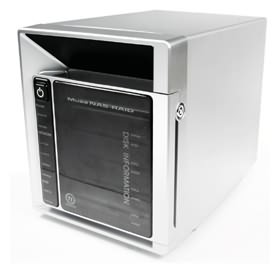 This
placement results in no audible noise (fan and/or drive) when listening to
music. The NAS is on a dedicated filtered AC line and as any audiophile dweeb
will do when they can, a Shakti Stone sits handsomely on its top. I run a Cat 6
cable to a Netgear gigabit switch which is then connected to the laptop via
another Cat 6 cable (and also to the other computers in-house so that they all
can share the NAS for storage). The NAs allows for redundant back-ups—meaning
that if one drive fails the files are stored on another. It also allows for
hot-swapping, meaning that I just insert another HD for the bad one and the unit
re-builds the files with no down-time. Cool… but not cheap, though for around $1000 for
the 1.5TB set-up (expandable to 2TB) that I have here, I am good to go (allowing
me to rip about 5000 CDs in a lossless file format).
This
placement results in no audible noise (fan and/or drive) when listening to
music. The NAS is on a dedicated filtered AC line and as any audiophile dweeb
will do when they can, a Shakti Stone sits handsomely on its top. I run a Cat 6
cable to a Netgear gigabit switch which is then connected to the laptop via
another Cat 6 cable (and also to the other computers in-house so that they all
can share the NAS for storage). The NAs allows for redundant back-ups—meaning
that if one drive fails the files are stored on another. It also allows for
hot-swapping, meaning that I just insert another HD for the bad one and the unit
re-builds the files with no down-time. Cool… but not cheap, though for around $1000 for
the 1.5TB set-up (expandable to 2TB) that I have here, I am good to go (allowing
me to rip about 5000 CDs in a lossless file format).
Ah… but things just don't work that easy with computer-based audio systems. See the Dell simply would crap out. While playing back music the USB output was simply not up to snuff. Buffering issues resulted in the occasional "pop and click"—dropouts in the music that was very annoying. Trying everything that I and a team of experts could muster from our expansive base knowledge relating to computers and their inner workings resulted in some improvements, but I was never able to get the "pops and clicks" to completely disappear. Different drivers are an option (ASIO4ALL) as is the use of a USB PCI card as either is supposed to address the laptop's inferior USB implementation allowing for a clean output stream. But in researching all that was going on in the Dell, there appeared be other potential issues… see iTunes and PCs are not necessarily the best match. One should use something like JRiver or Foobar (along with EAC to rip your CDs) to get the best sound from either an XP or Vista machine (along with other potential setbacks like KMIXER, etc.), so in the back of my mind I start to think that perhaps it is time to get a Mac. After all, word is that a Mac Book is simply a plug and play experience with iTunes—makes sense since it is running on a native platform. Plus, there are no USB issues, no compatibility issues, and an easy set-up… hey …no hassle! Check out iTunes set-up guides by doing a search on the web, or save yourself some time and just go to the Wavelength Audio website. Gordon has a very good explanation on how best to set up iTunes on either a Mac or PC. Just buy a really good PC!
So I take the Mac plunge and, using my Educators discount (a whopping $100 savings), order the top of the line basic Mac Book ($1400 in black with 2.42.4GHz Intel Core 2 Duo processor , 2GB or memory, and a 250GB hard drive, though I don't really care about the hard drive since I am using the NAS to store my music files). Very slick. Very cool… and it works right out of the box! No dropouts, no issues, and no blue screens. Music plays and it sounds quite good. I like iTunes set to 24 bits/44.1kHz as opposed to 24/96. I prefer letting the Cary do any up-sampling (via hardware) as opposed to the Mac (via software) simply because it sounds better that way. Setting the Mac to 24/96—regardless of the setting on the Cary—was not my cup of tea musically. At this setting my music was lean and threadbare; lacking in color and richness. Nothing dramatic, but clearly audible.
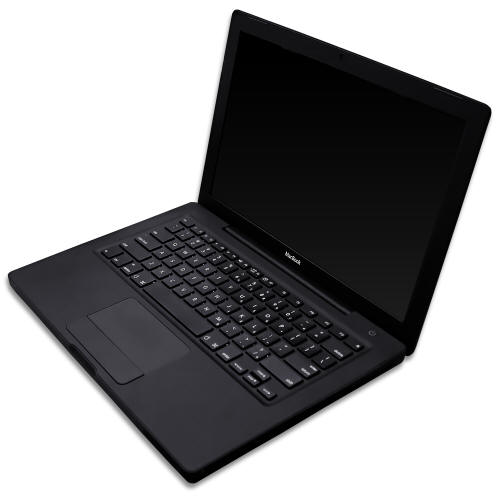
And what is really cool is that the Mac Book has an optical (Toslink) out negating the need for a USB converter… after all simpler is better, yes? Uh… No. Using the optical out on the Mac (mini-Toslink on the Mac to a regular Toslink for the digital in at the Cary 306) sounds okay. But in all actuality it sounds quite a bit like that of the Hagerman …very nice, but not the end all to be all. Simply put, music via Toslink direct to the Cary possess a lack of depth, a believable sense of spatial presence, muted dynamics, and desirable resolution is down several notches, etc.. It works, but more for ease and background music; not for any real sense of what one would hear from something approaching an audiophile approved presentation. Why so? Jitter my man. The optical, while fine in many ways (allows for an electrical separation of the laptop and Cary DAC—no noise traversing between the two which is good), in this implementation is inherently jitter rich. Apparently the Cary cannot deal with that amount of jitter and so while it does sound fine on the cheap, it is not the ultimate way to go; unless you run the Toslink into a re-clocker (like the Pace Car from Empirical Audio …yeah, got one on the way!). Till then it is USB out and USB seems to work mighty fine.
Except even on a Mac one has to carefully choose which USB port to use. Seems that not all USBs are created equally. The USB port to the right is actually Hot and the one to the left is not (the Mac Book has only two USB ports which can be found on the left hand side). So use the one on the right. it should work better.
Even so is this the best way to go? No doubt using fire-wire into something or other, or even Toslink into a re-clocker might be a better—at least that is the skinny being tossed around on the web. Same for scrapping iTunes and turning to the pro-side of software to manage my files and playing them back, as well the choice of file type, the ripping software (EAC is way too much for me to deal with at this time—and besides, not so sure it really matters as iTunes seems to be doing a pretty good job), and yadda, yadda, yadda …. But right now, I like what I hear.
Is it better than the Cary or EMM spinning a CD? No it ain't… it is different but not different in a way that is worse or better …just different. Like a different CD player, a really good CD player. The Cary is a bit more of that and the computer is a bit more of this, same for the EMM …just different. But word is that if done right (and many suggest that the way I have it done is right and many suggest otherwise …gee sounds like audio doesn't it?) it should be WAY better …not just different. Is it an issue of the digital inputs on the Cary? Are they all created equally? In checking with the digital folks at Cary the response is that all inputs go through the same circuit as that of a spinning disc; same digital and analog circuits. The only difference is that the three inputs do see an isolation transformer that converts the signal to that of balanced …so then perhaps AES/EBU might be a better fit? Don't know till the Pace Car arrives (it is set-up to output AES/EBU and since I do not have any cables here am unable to try the Pop Pulse).
A USB DAC? Maybe… but I wanted to keep it simple. If I go the different DAC route (and I have no plans on scrapping either the Cary 306 or the EMM CDSA SE) then I really will be playing with too many options—three different digital sources along with analog. Even so, I do have here both Benchmarks: the DAC1 and DAC1Pre (both USB models), and well … yeah the reviews are right on regarding either of these two DACs. The latest Absolute Sound features Robert Greene's review on the DAC1 Pre and he is correct in suggesting that it is as good as it gets. Ditto what John Atkinson says in Stereophile regarding the DAC1. Both are killer products… but then I am just getting things a bit too complex in my main rig. Yeah, either Benchmark works and sounds wonderful with the Mac, but then I am moving away from using the Cary's inputs to maintain that Cary sound. They sound great, but they sound different just like the Mac does when feeding a stream into the Cary. Going with either Benchmark is just moving sideways and not really forward. Perhaps a computer based system requires something other than what the Cary and Benchmark can offer; perhaps the Cary inputs are not perfect… though the Cary's DAC is no doubt competitive with many standalone DACs at any reasonable price. Then again, perhaps computer based audio is not better… just different. So choose your poison wisely young man.

But right now the music plays on, which is what it's all about. It is quite good, fun, and easy to play whatever I want without have to find that one CD to play that one song. And the ability to download stuff that is simply no longer available or hard to find! How cool is that?! There are so many sites out there to choose from… though they do disappear from time to time!
Caveats on tweaking
Isolate the computer/laptop from the rest of your system. Placing the laptop on the shelf above my Cary SLP-05 resulted in audible hum and noise. Moving the laptop to another shelf to the side—along with sheets of ERS cloth between the laptop and Cary 306—resulted in a dead quiet presentation, well… other than the music playing.
Use of some form of isolation feet under the laptop to mitigate vibrations and such (IsoNodes from Bright Star worked fine) is a good idea. After all it is an electronic device and as such might be susceptible to vibrations and such.
Trying an old Cable Jacket from Shun Mook on the Cat 6 cable is a no-no… loss of dynamics and slam with the sound becoming sort of dull and compressed. Leave the Cat alone.
Minimizing the work that the operating system sees helps to maximize the sound; something to do with how the lossless files are being converted and the processor being taxed by other applications. Though I am not so sure this is all that audible or relevant to the Mac. In looking at the Mac's processor's CPU usage, the Mac is pretty much on cruise control. Of course it is also suggested elsewhere that in converting Apple lossless files results in a degradation of sort in terms of the bits/information or something even more sinister—that Apples' conversion is not perfect—and so by not saving music in Apple lossless (using AIFF or something else) will get you better sound. Got me …sounds awfully good as is. Could it be better? Perhaps. Perhaps Apple is working on a better version of iTunes!
AC conditioning helps. The Mac runs on batteries (trickle charge when connected to AC) but still benefits from AC conditioning… ditto the NAS and anything else. The USB converters have the option of batteries (at least the Pop Pulse and Off-Ramp do, the HagUSB runs of the USB) and sound much better when feed as such.
More to come…
Hagerman Technology www.hagtech.com
Cryo-Parts www.cryo-parts.com
Empirical Audio www.empiricalaudio.com
Purist Audio Designs www.puristaudiodesign.com
Blue Jean Cable www.bluejeanscable.com
Signal Cable www.signalcable.com
Moon Audio www.moon-audio.com
